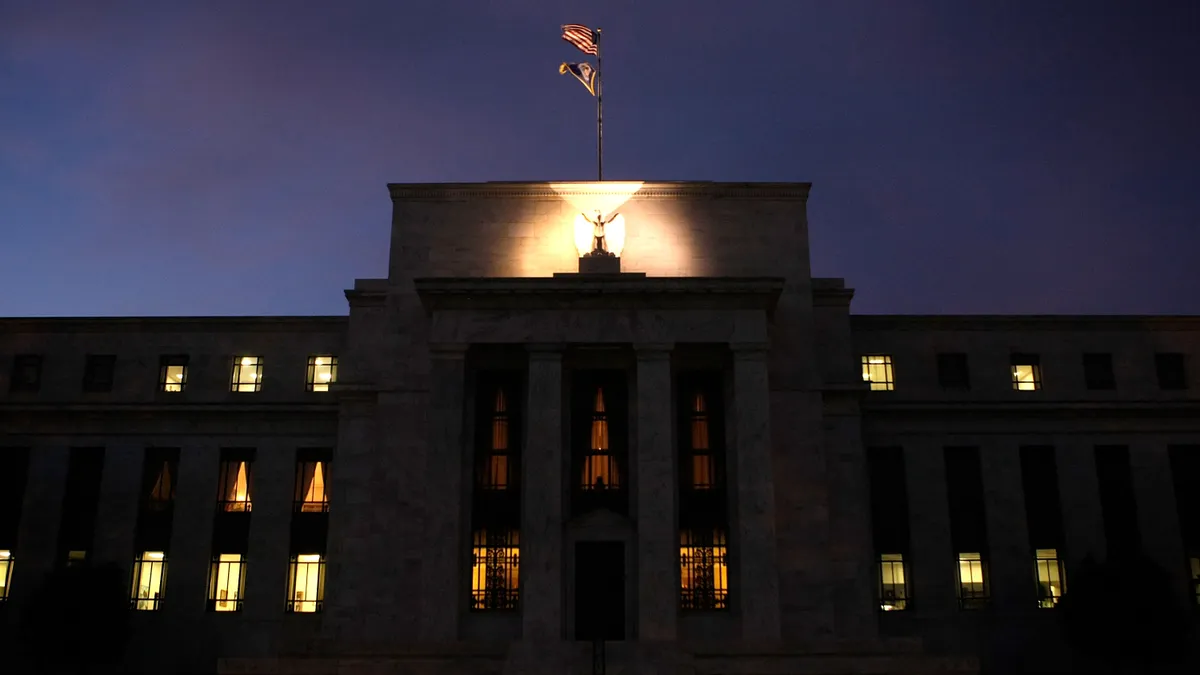Dive Brief:
- The Federal Reserve, in response to a mild recession starting in the first quarter, may soften its fight against inflation and begin cutting the federal funds rate in mid-2023, reversing the most aggressive increase in borrowing costs since the 1980s, Fannie Mae economists said Monday.
- The U.S. economy will shrink 0.5% next year amid weak manufacturing and both reduced spending and rising debt among consumers, Fannie Mae economists said. A decline in the Conference Board’s Leading Economic Index for eight consecutive months through October and an inverted yield curve — with short-term Treasury yields exceeding long-term yields — point to a mild downturn in the next few months, they said.
- “The most inverted yield curve in more than 40 years demonstrates market expectations that the Fed will cut its target rate more quickly than current guidance from the Fed,” Fannie Mae economists said in a report. “Given that we are expecting a general downturn to occur, we see market expectations for the Fed to start cutting rates mid-next year as plausible,” the economists said, adding that policymakers may not reverse course if the economy avoids recession and the labor market remains tight.
Dive Insight:
Fed officials on Wednesday increased the federal funds rate a half point to a range between 4.25% and 4.5% and forecast that they will raise the main rate by the end of next year to 5.1%, a half point higher than their 4.6% prediction in September. They predict that they’ll trim the benchmark rate in 2024 to 4.1%
“We have more work to do,” Fed Chair Jerome Powell said after a two-day meeting of policymakers.
“The historical record cautions strongly against prematurely loosening policy,” he said during a press conference. “We will stay the course until the job is done.”
Goldman Sachs economists forecast that the Fed next year will push up the main interest rate to a peak range of 5% to 5.25% by increasing the benchmark by 0.25 percentage point at each of its meetings in February, March and May. They do not expect that inflation will slow enough in 2023 to prompt a reduction in borrowing costs, noting that on Wednesday “Powell said that the [Federal Open Market Committee] will only cut when it is confident that inflation is moving down in a sustained way.”
The central bank holds a brighter view of economic growth next year than Fannie Mae economists. Fed officials see gross domestic product expanding 0.5% in 2023 compared with their September estimates of 1.2%. For 2024, they predict 1.6% economic growth compared with Fannie Mae’s 2.2% estimate.
Policymakers, after underestimating the threat of price pressures in 2021, have pushed up the benchmark interest rate at seven consecutive meetings this year for a total of 4.25 percentage points. More rate increases are in the cards for 2023 as the Fed fights the hottest price gains in nearly 40 years, Powell said Wednesday.
Persistent increases in wages may erode optimism prompted by a slowing in the 12-month increase in the Consumer Price Index last month to 7.1% from 7.7% in October, Fannie Mae said.
“As long as the labor market remains strong and wage growth remains higher than what is consistent with [the Fed’s] 2% inflation target, we believe the Fed will continue with restrictive monetary policy, further slowing the economy,” Fannie Mae said.
“Given the lagging nature labor markets, the historical downward stickiness of wages and time lags in measurement, we may not see concrete evidence of slowing wage growth for quite some time, even if a recession does in fact begin the first quarter of 2023, as we currently predict,” Fannie Mae said.















